The year 1907 marked the 300th anniversary of the English settlement at Jamestown, Virginia. To celebrate the occasion, a grand Jamestown Tercentennial Exposition was organized – one of a series of world’s fairs where states and nations gathered to showcase their brilliant arts and technological innovations. Such luminaries as U.S. President Teddy Roosevelt, author Mark Twain, and educator Booker T. Washington graced the eastern Virginia shores over the 7-month exposition.
A deferred tribute to the “Jamestown Maiden”
A year prior to the Jamestown Exposition, a Virginia woman by the name of Anne Sanford Green of Culpeper, Virginia, mused on the casting of a new bell to commemorate Jamestown’s 300th anniversary. Mrs. Green was one of the early charter members of the Daughters of the American Revolution and also of the United Daughters of the Confederacy, the latter significantly influencing the bell’s casting. On February 17, 1906, Mrs. Green gathered “a meeting of southern women” in the parlors of the Montrose Hotel to organize a new group of ladies under the banner of the Pocahontas Bell Association.

Composite image: Anne S. Green, née McDonald, convenor of the Pocahontas Bell Association (left) and a photograph circa 1906 of the ruins of the Jamestown church tower. Courtesy: Library of Congress.
The objectives of the association meandered somewhat over its short existence. At the start, their stated purpose was to provide funds for the casting of a new bell, to be placed in the belfry of the old stone church at Jamestown, which was then being restored by the Society of Colonial Dames. In a May 10, 1906, column, The National Tribune rhapsodized on the bucolic environs: “…the familiar ruins of the old tower looked on at the wedding of John Rolfe, English gentleman, and Pocahontas, the first American belle.”
Mrs. Green was joined by Mrs. Wilson Cary as co-chair of the new association, along with Mrs. Frances Hill Horn as secretary and Mrs. Albert Aker as treasurer. General membership was capped at 100 individuals. Very quickly, the objectives changed. Instead of a new bell in an old church, the Pocahontas Bell Association would cast a bell to be displayed at the Jamestown Exposition, using American Revolutionary War-era arms in the bell metal. With Jamestown a short distance to Williamsburg, the bell was offered to the College of William & Mary for hanging after the Exposition. The venerable institution declined on the grounds it already had a bell.
Casting the Pocahontas Bell
The Pocahontas Bell Association petitioned Congress to give them authority to smelt old cannons, guns, and pieces of battleships. Congress agreed in a March 2, 1907, “Joint Resolution Authorizing the Secretary of the Navy to Furnish Metal for a Bell.”
Resolved by the Senate and House of Representatives of the United States of America in Congress assembled, That the Secretary of the Navy be, and is hereby, authorized to deliver to the Pocahontas Bell Association, if the same can be done without detriment to the public service, such condemned historic metal as he may deem proper, not to exceed two thousand pounds in weight, to be used in casting a bell to be placed on the Virginia building at the Jamestown Exposition:
Provided, That the Government shall be at no expense in connection with this gift.
There is some debate about whether the metal ever arrived, with a contemporary of Mrs. Green lamenting, “If Congress had helped in the matter, a much larger bell would have been the result.” The association invited “women of other states to assist to make this coming exposition worthy of this Indian princess who saved the colony from massacre and starvation.” The bell would serve as a “deferred tribute to this famous woman.” Individuals from across America contributed gold, silver, and historical memorabilia to be added to the casting, enough to account for one-tenth of the final weight.
The bell was molded by Wilson M. Cary, Jr., owner of the McShane Bell Foundry in Baltimore, Maryland, and lineal descendant of Pocahontas, who donated his time. On April 12, 1907, Mrs. Green and the officers of the Pocahontas Bell Association gathered at the foundry. By the light of a candle in an old candle stick, once owned by Samuel Mathews, a royal governor of Virginia, the first pieces of metal were dropped in the crucible. The candle was meant to suggest the “work of the present, being aided by the light of other days.”
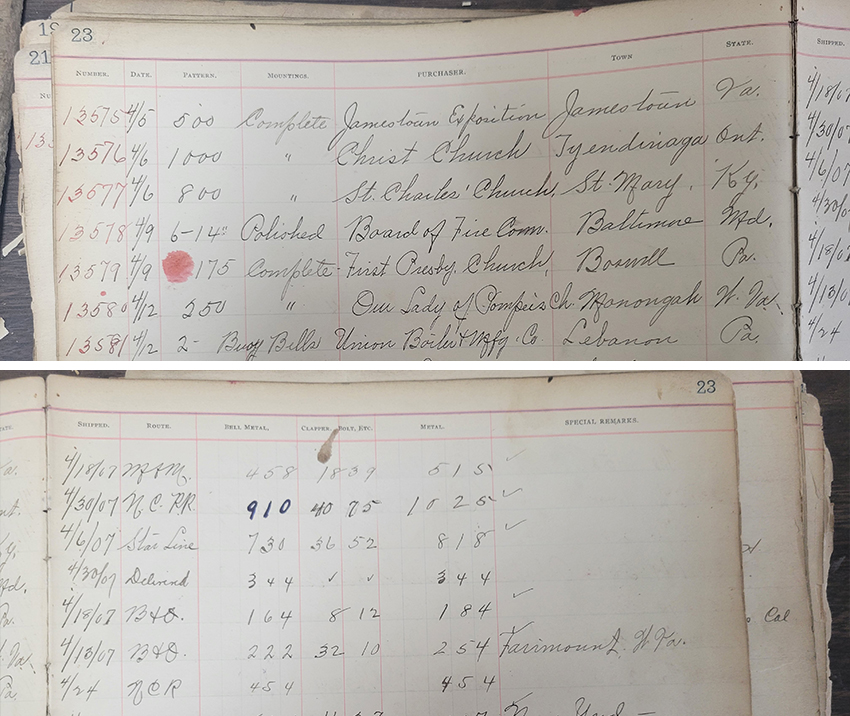
Composite image: An entry dated April 5, 1907, in the McShane Bell Foundry logs (first line on both the left (top) and right pages) lists order No. 13575 for a new bell and complete mountings. The Jamestown Exposition is the indicated purchaser. Courtesy: McShane Bell Company.
The casting contained a melted-down spur from Confederate Major John Pelham, a bracelet from a chief of the Puyallup Tribe, a finger ring worn by Henry Clay, an armor plate from the CSS Virginia warship, and nails from Libby Prison. Schoolchildren across the nation collected pennies for the cause. Mrs. Green’s “southern women” amassed a veritable bevy of national relics and memorabilia to be smelted for the casting. The last item of historical value tipped into the crucible was a fragment of the Columbian Bell, cast for the 1893 World’s Columbian Exposition in Chicago, Illinois.
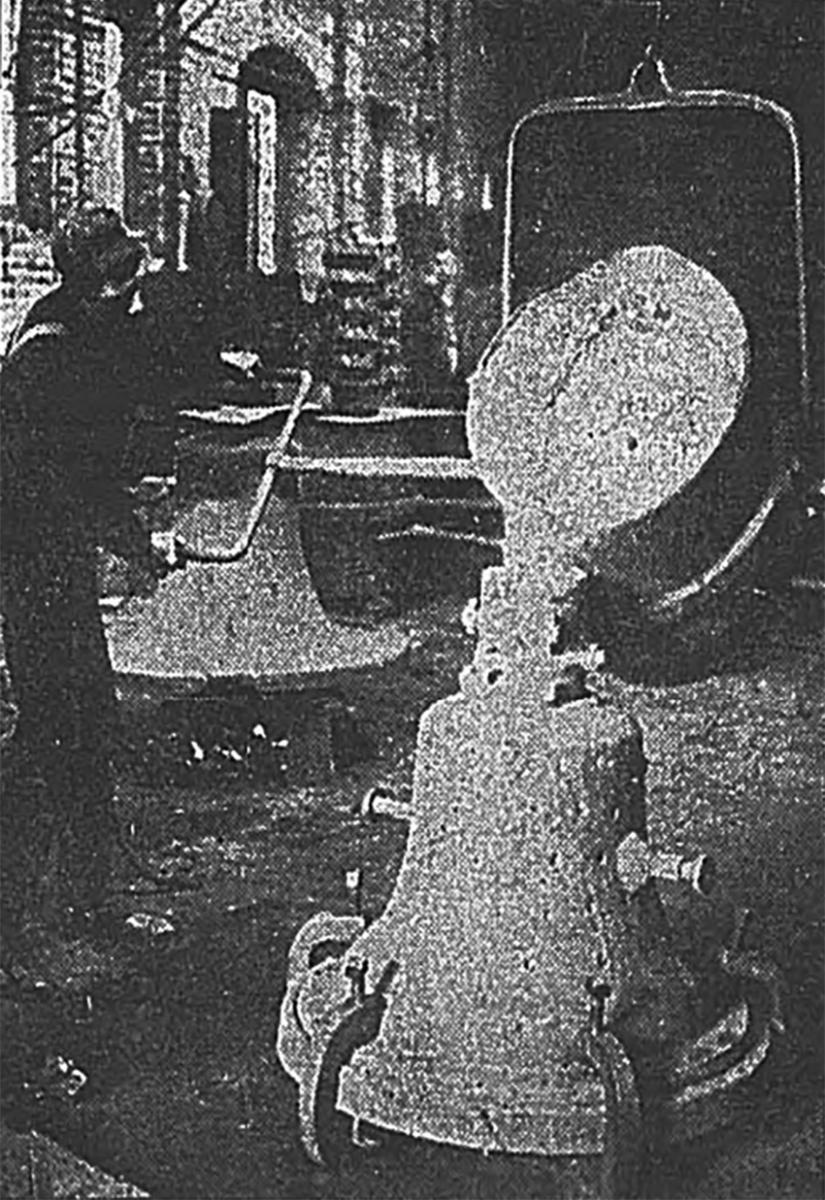
Image: A black-and-white photograph printed in The Fairmont West Virginian newspaper on April 27, 1907, shows a bellmaker at the McShane Bell Foundry in Baltimore, Maryland, pouring molten bronze into a mold of the Pocahontas Bell.
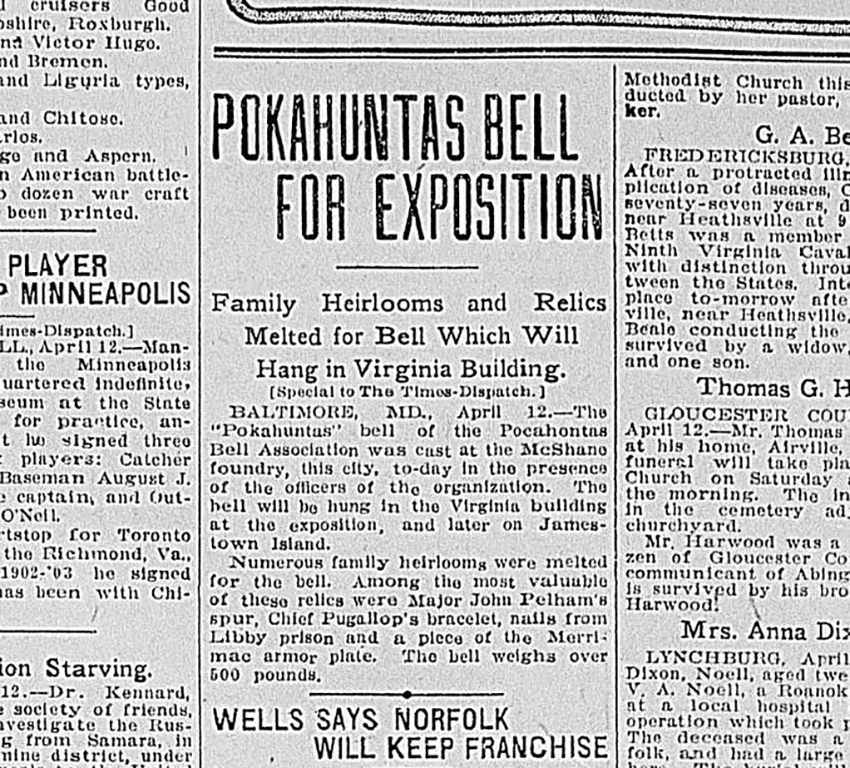
Image: Newspaper clipping from The Times Dispatch dated April 13, 1907, recounting the casting of the Pocahontas Bell. Courtesy: Library of Virginia.
The resultant bell, cast in the foundry’s ‘500’ pattern with a 29” diameter, consisted of 458 lbs. of bell metal, an 18-lb. clapper, and 39 lbs. of fittings for a total weight of 515 lbs. When sounded, it had a tone of C natural. The bell was shipped from the foundry on April 18, 1907, bound for Jamestown. An inscription cast in bronze on the obverse uses an earlier spelling of Pocahontas and reads:
“THE BELL POKAHUNTAS.”
THE POKAHUNTAS BELL ASSN.
ANNE S. GREEN, PRESIDENT,
WILSON MILES CARY, VICE – PRESIDENT.
THESE MINGLED METALS RICH AND KIND
THEIR PURPOSE HIGH, INTENT, SUBLIME.
JAMES TOWN 1607 – 1907. AMEN.
The reverse face of the bell presents the following inscription above a foundry mark identifying the McShane Bell Foundry:
THE DOMINION 1607 VIRGINIA 1907
BLEST BE THE TIE WHICH BINDS
ALL FAITHFUL HEARTS TOGETHER
THROUGH SONGFUL SUMMER TIME
THROUGH STORMY, WINTRY WEATHER.
To accompany the new bell, Mrs. Green published a short work, The Maid of Jamestown, containing “many romantic facts and incidents hitherto unexploited, if not unknown to the majority of readers, relating to the first acquaintance, early friendship, and association between Pocahontas and Capt. Smith.”
Installation and reception at the Jamestown Exposition
By this time, the Pocahontas Bell Association had pledged the bell to the governor of Virginia, to be hung on top of the Virginia State Building, a grand colonial homestead, throughout the duration of the Jamestown Exposition. It was also announced that at the conclusion of the fair, the bell would be entrusted to the custodianship of the faculty of the University of Virginia. Both plans changed.
The proposal to hang the bell at the Virginia State Building fell through and the Pocahontas Bell Association scrambled for an alternate location for installation. A suitable spot was found on the land allotted to Kentucky for the fair – a dense pine grove at the western extremity of the Exposition grounds. On this site was erected a reconstruction of Fort Boonesborough, the frontier fort founded by Daniel Boone.

Image: A 1907 photograph printed on a postcard of the front entrance of Fort Boonesborough, reconstructed for the Jamestown Exposition at Sewell's Point on Hampton Roads, in Norfolk, Virginia. Courtesy: University of Kentucky, Special Collections Research Center.
A report issued by the Kentucky Jamestown Exposition Commission, written by Secretary C.C. Ousley, gave a somewhat rosy and charitable description of how the bell ended up in the environs of the Kentucky camp:
“It was originally intended that the bell should hang in the reservation surrounding the Virginia Building. When members of the Association had looked over the grounds, they unanimously decided that the most appropriate surroundings were to be found at the Kentucky Building and permission was asked of the Kentucky Commission that the bell might hang in front of Fort Boonesboro[ugh]. Consent was readily given and a rustic belfry of four upright logs was erected.”
That Pocahontas had no connection to Kentucky was moot. “The location is ideal so far as regards the early settlement days which the bell represents,” read a column in The Richmond Times-Dispatch from May 6, 1907. The bell finally had a home in a rough-hewn (and some might argue hastily-assembled) display. Hung within the rustic log stockade of the fort, to the right of the main entrance, the bell was dedicated during a formal ceremony on June 15, 1907 – 50 days after the start of the Exposition and 28 days after May 18, when Mrs. Green had earlier announced the bell would first “ring out its peaceful tones.”
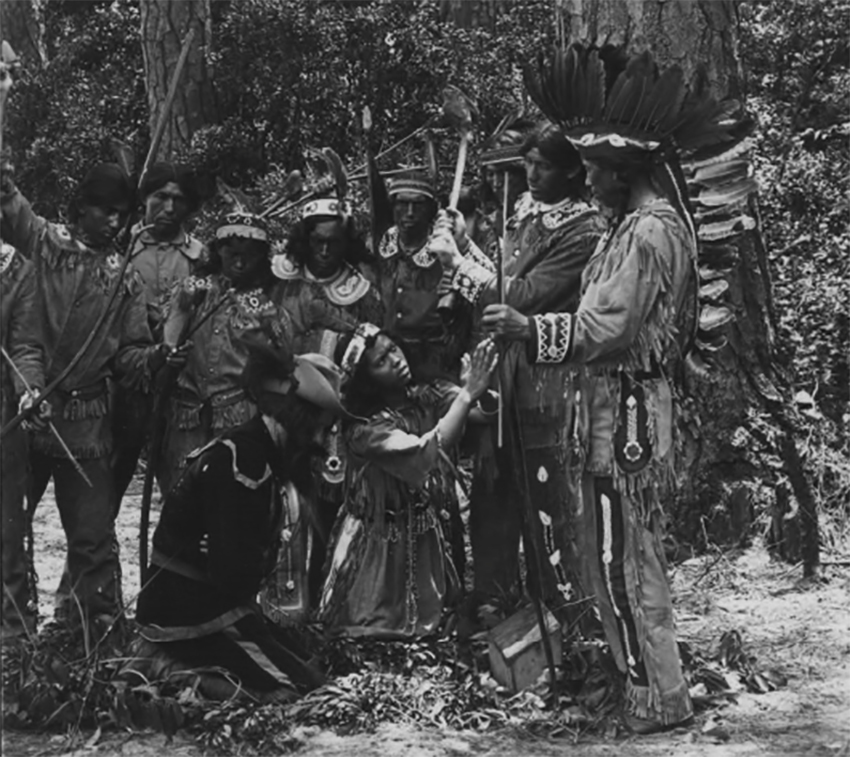
Image: Photograph of a reenactment by the Pamunkey Tribe during the 1907 Jamestown Exposition entitled, “Capt. John Smith About to be Killed by Powhatan is Spared by the Plea of Pocahontas.” Courtesy: University of California Riverside, California Museum of Photography.
The dedication was attended by Mrs. Green and members of the Pocahontas Bell Association, while an address was made by the governor of Virginia, Claude A. Swanson, among others. Following the governor’s oration, a young granddaughter of Mrs. Green had the honor of ringing the first toll, which was greeted by cheers.
Flags given by the U.S. government draped the belfry, around which was constructed a temporary platform for the gathered dignitaries. Even more flags and bunting festooned the fort, as music from the band of the University of Missouri wafted over some 500 people in attendance. A poem written for the occasion by Folger McKinsey, known as “The Bentztown Bard,” was read by Mrs. N. G. Grant of Denver, Colorado.
The Pocahontas Bell finds a new home
A June 23, 1907, missive from The Washington Herald began: “The destination of the Pocahontas Bell has not been decided nor will it be announced before December 1. It was presented to the Tercentennial Exposition and will remain upon the grounds until this date. Mrs. A. S. Green, who is president, says this, and she knows what she is talking about. On account of so many conflicting statements she thinks it is best to give the facts.”
At the close of the Jamestown Exposition, the various attractions were shuttered and the amassed collections were dispersed back to their homes. It was decided that the Pocahontas Bell should not be tendered to the University of Virginia, as had been the most recent suggestion. Speaking in 1957, a daughter of Mrs. Green indicated that her mother had retained the bell because the faculty refused to hang it on top of the Rotunda. Instead, it would be formally transferred to the commissioners of the Jamestown Exposition, to be placed on government-owned land on Jamestown Island, near the monument to Capt. John Smith.
On April 21, 1908, Mrs. Green read aloud a communication from Governor Swanson of Virginia, in which he relinquished all claim to the bell that had been previously promised to him. This was the last the public had heard of the Pocahontas Bell.
In January 1957 (50 years after the casting of the Pocahontas Bell), a descendent of Confederate General Robert E. Lee wondered where the coins and other metal objects her family had contributed to the bell's casting from Arlington House, the historic Lee family residence, had ended up. The Arlington Historical Society offered a cash prize for information on the bell's whereabouts.
“We have inquired of the Association for the Preservation of Virginia Antiquities and [members of] the Virginia Historical Society,” said Charles Harrison “Hank” Mann, Jr., the first president of the latter society. “Thus far, there have been no results. It seems that it would be a little hard to misplace a 500-lb. bell, but apparently not.”
Where had it gone? The bell made it to one of the Exposition's commissioners as promised, but it didn't make it out of the family. The bell was tendered to Thomas Dudley Stokes, who helped organize the fair. He also happened to be Mrs. Green's son-in-law. He and his wife Susan, Mrs. Green's daughter, installed the bell at their home on sprawling lands in Goochland County, Virginia.
The Pocahontas Bell at Elk Hill
The Stokes’ home in Goochland County, Virginia, was situated on a hill near the confluence of Byrd Creek and the James River. Called Elk Hill, or Elkhill in earlier days, the considerable plantation with hilltop views once belonged to Thomas Jefferson. For a time during the Revolutionary War, Elk Hill was occupied by Lord Cornwallis, who, bemoaned Mr. Jefferson in a letter dated 1788, oversaw vast plundering of food and furnishings.
After changing hands several times during the 19th century, the Stokes family purchased Elk Hill in 1902 and maintained the country seat for four decades. The Pocahontas Bell was brought to the property in 1908, a distance of 110 miles as the crow flies from the Jamestown Exposition. In 1943, Richmond-based businessman and philanthropist S. Buford Scott purchased the home and secured several of the Stokes’ personal effects, including the bell, at auction. He encased the Pocahontas Bell in a purpose-built belfry with a pitched slate roof next to the estate manager's house.
In 1970, Mr. Scott’s son of the same name sold this 350-acre plantation to create Elk Hill Farm Inc., a nonprofit organization that provides residential, health, and educational services for low-income youth. The Pocahontas Bell remains on this land today, secured in storage and patiently awaiting refurbishment.
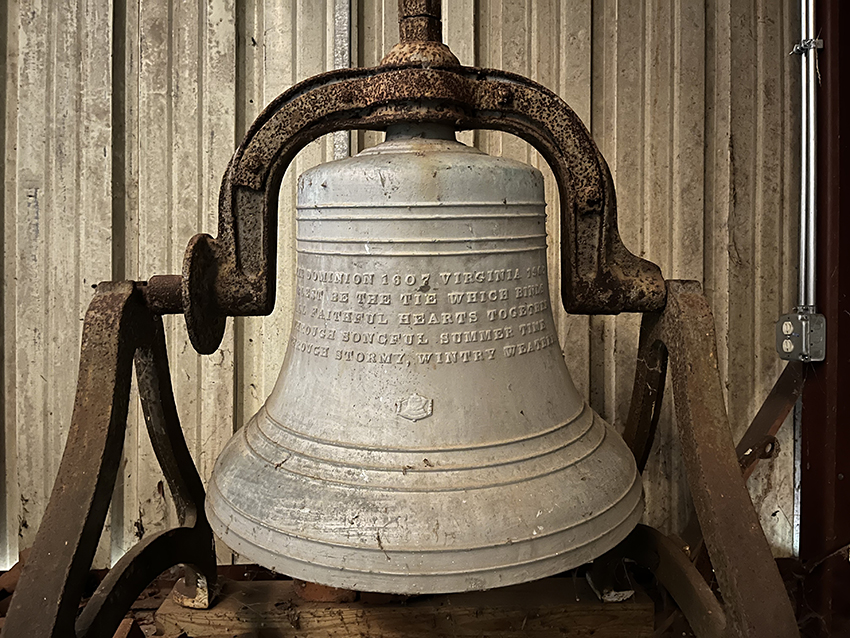
Image: The Pocahontas Bell in storage at Elk Hill in Goochland County, Virginia, on August 5, 2023, before needed refurbishment work.
The original iron yoke and A-frame of the bell betray the oxidation and wear of a century of use. At some point, a significant crack in the yoke was repaired with the addition of an iron brace. The bell itself is in excellent condition, save for an inch-wide chip on the lip. The National Bell Festival is pleased to work in concert with the team at Elk Hill on the care, restoration, and rededication of this singular bell. It will soon ring again.
Calling all historians and internet sleuths!
The National Bell Festival is on the hunt for a photograph of the Pocahontas Bell in situ on the 1907 Jamestown Exposition grounds. The bell would have been located within the log stockade of the Kentucky Building (the Fort Boonesborough recreation), to the right of the main entrance. Have any information to share? Give us a ring!
Cover image: A statue of Pocahontas by sculptor William Ordway Partridge, commissioned for the 1907 Jamestown Exposition, stands watch over Pocahontas St. and the Exposition’s main square from the steps of the stately Auditorium Building in Jamestown, Virginia.

